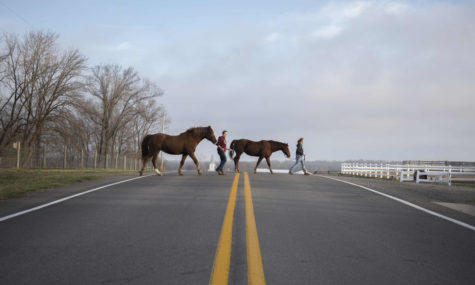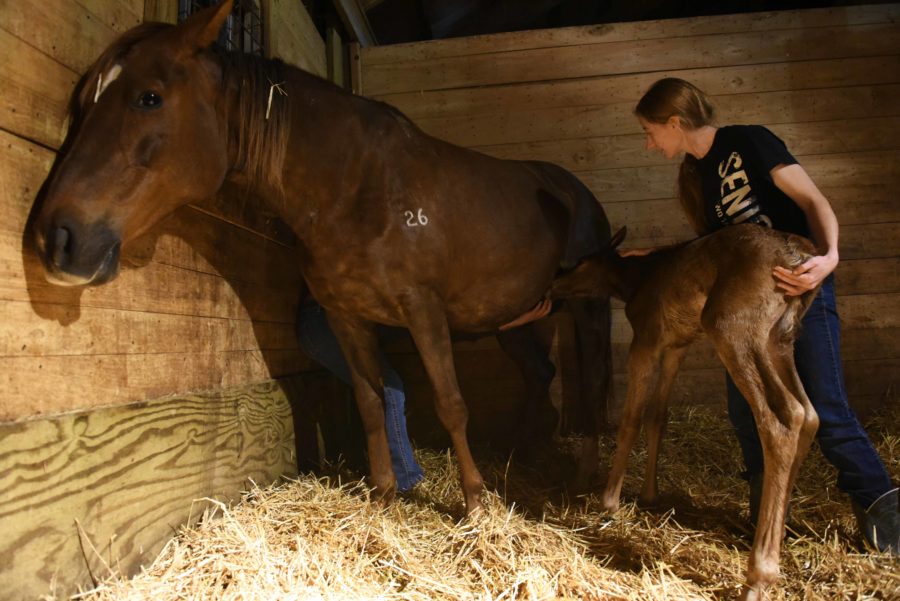‘The farms are our classrooms’: budget impasse threatens University Farms
Michael Halpin, a senior from Dorchester studying equine science, and Sheila Puckett, an agricultural research technician, attempt to get a newborn foal to feed for the first time Tuesday, April 11, 2017, at the University Farms’ Equine Center. The foal was born to Honey, a mare owned by the university. The foal was named Marvel in reference to Marvel Comics, which was the theme for foal names they picked for the year. (Bill Lukitsch | @lukitsbill)
April 20, 2017
Lillian Hayhurst’s passion is cattle.
“Being surrounded by hills and cows is my heaven,” Hayhurst said. “Without University Farms, college would have been miserable.”
Hayhurst, a senior studying animal science and cattle management, moved to Carbondale in 2014 from her family farm in Terre Haute, Indiana, to enroll in SIU’s agriculture program and work at University Farms. The 2,000 acre facility offers hands-on experience for almost 600 students at its 15 research facilities, and is one of 15 centers or initiatives SIU’s non-academic prioritization committee suggested could become self-supporting with the goal of eliminating state funding by 2022.
Advertisement
The non-academic prioritization committee suggested cutting $108,034 of state funding from the farm’s budget.
The University farms consist of over 600 acres of row crop research and production, 120 acres of hay production for livestock, 300 acres of pasture for Animal Centers and 1,000 acres of forest and watershed areas used for research and teaching.
The farms also house a compost center which was set up primarily to process approximately 12,800 pounds of vegetable waste generated each year from the university’s dining halls. The compost is then used as a fertility amendment for vegetable crops.
Karen Midden, associate dean of agricultural sciences, said while students’ research funds are solely reliant on grants, the cuts would hinder the farm’s ability to maintain the wildlife that students are actively researching.
“It’s easy for people sitting behind a desk to cut the budget,” Hayhurst said, while explaining that administrators should research the extensive farm work students do before making significant cuts to the facilities. “When they see the hardworking people behind the cuts, they might have a different view on it.”

Since July 2015, Republican Gov. Bruce Rauner and Democrats who control the state Legislature have failed to come to an agreement on a state spending plan. In light of the state’s historic budget impasse, public universities are considering ways to continue operations with the assumption that some funding could be cut permanently.
Two stopgap measures passed in 2016 totaled $83 million of financial support for the SIU system. Those funds, for the most part, were used to pay the bills from the 2016 fiscal year. The university started the 2017 fiscal year “basically back at zero” and is dipping into the reserves once again, SIU President Randy Dunn has said.
Advertisement*
The 15 institutions or centers identified in the non-instructional prioritization committee’s report suffered a permanent 10 percent reduction in state funding in fiscal year 2016. Others saw additional cuts in the 2017 fiscal year
Dunn said on March 29 the Carbondale campus should cut at least $30 million in spending and should consider declaring a short-term financial emergency. Interim Chancellor Brad Colwell released a statement in response detailing the cuts at the campus level, which include $1.2 million from partially self-supporting units like the University Farms.
The cuts outlined in Colwell’s statement are for the 2018 fiscal year and are based in part on proposals for long term efficiencies such as those in the non-academic prioritization report.
The Daily Egyptian is publishing a series of stories to examine the effect those proposed cuts would have on the university community. This is the tenth in the series.
Hayhurst said in her time at the farms she has taken four different classes involving the treatment of cattle. Activities in her class involved sitting with hogs in labor for up to four hours and performing ultrasounds on pregnant horses and cows.
Ben Westrich, who has completed two research assignments at the farms in his three years at SIU, said any cuts to the facilities would change the “uniqueness of the farms.”
“I’ve never seen any place like the farms at any college,” said Westrich, a junior from Marion studying crop and soil management.
Westrich was invited to the International Research Conference in Phoenix as a result of his University Farms research, which had him planting crops and testing soil for up to 30 hours a week.
“The farms are our classrooms,” Westrich said. “Any cut to the facilities would cut that class time.”

Midden said the farms are also a major recruiting component because many students are given research opportunities their freshman year. She said the early hands-on experience creates a high retention rate in the agriculture school, which benefits the university as a whole.
“To classify the farms as non-academic is a poor evaluation,” Midden said. “Any hit to the farms will hurt the university.”
Midden said University Farms is also tasked with hosting Future Farmers of America cattle judging and planning recruitment events which bring hundreds of high school students to the farms. She said juggling these responsibilities will be nearly impossible if state funding is cut from the farms.
Midden said the only viable solution would be to sell crops yielded from the University Farms fields, but that capital “wouldn’t come close” to making up for the loss of state funds.
“If we are totally cut, I don’t think we can survive,” Midden said. “We haven’t made any decisions yet, but there’s not a lot here we can cut here.”
Hayhurst said for students from a small town, facilities like University Farms are crucial to the school’s identity.
“After moving to a bigger city like Carbondale, the farms give me a sense of home,” Hayhurst said.
Hayhurst said without the work at the farms, she would not have received the experiences she needs as she plans to take over her father’s farm, which has been in operation since the 1980s.
“Cattle has always been in the family,” Hayhurst said. “I couldn’t imagine a life without it.”
Staff writer Olivia Spiers can be reached at [email protected] or on Twitter @_spierso.
To stay up to date with all your southern Illinois news, follow the Daily Egyptian on Facebook and Twitter.
Advertisement







